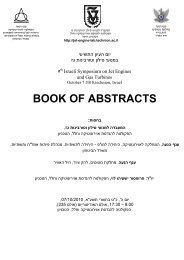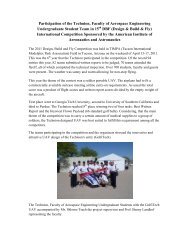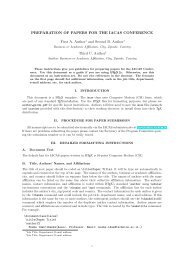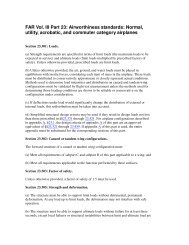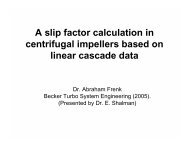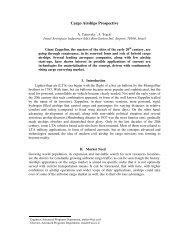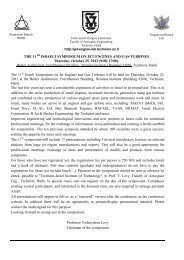A Century of Ramjet Propulsion Technology Evolution - Faculty of ...
A Century of Ramjet Propulsion Technology Evolution - Faculty of ...
A Century of Ramjet Propulsion Technology Evolution - Faculty of ...
You also want an ePaper? Increase the reach of your titles
YUMPU automatically turns print PDFs into web optimized ePapers that Google loves.
56 FRY<br />
will demonstrate the operation <strong>of</strong> the endothermically fueled scramjet<br />
engine in flight using a single flowpath and fixed-geometry,<br />
self-starting inlet. It is based on the use <strong>of</strong> the HyTech waverider<br />
two-dimensional engine configuration and features an army tactical<br />
missile system (ATACMS) solid propellant booster to accelerate the<br />
waverider test vehicle to a scramjet takeover Mach number <strong>of</strong> 4.5<br />
with the scramjet engine further accelerating the vehicle to Mach<br />
7. Five test flights are planned starting in 2005–2006 to precede the<br />
X-43C flight tests.<br />
The most ambitious application <strong>of</strong> the U.S. HyTech technology is<br />
the joint NASA–U.S. Air Force X-43C program. This program seeks<br />
to develop waverider flight-test vehicles that will accelerate from<br />
Mach 5.5 to 7 using three flowpaths developed from the HyTech<br />
hydrocarbon-fueled scramjet engine. Each flight-weight fuel-cooled<br />
flowpath will feature the variable-geometry cowl flap <strong>of</strong> the GDE-<br />
2 engine. Like the X-43A, the X-43C will be air launched from<br />
a L-1011 and accelerated by a Pegasus solid propellant booster<br />
to Mach 7+. Ground testing will include single- and multi-module<br />
nose-to-tail propulsion airframe integration demonstrators and flight<br />
clearance engines. Three flight tests are scheduled, beginning in<br />
2007.<br />
General State <strong>of</strong> <strong>Ramjet</strong>, Scramjet, and Mixed<br />
Cycle <strong>Technology</strong><br />
Flight-Demonstrated <strong>Technology</strong><br />
The state <strong>of</strong> the flight-demonstrated ramjet technology base in<br />
1980 was summarized by Thomas87 and is shown here in Fig. 42.<br />
Fewer operational ramjet systems were known to have existed in<br />
the open literature. Those actually in existence included subsonic<br />
U.S. Navy drones, Bomarc, Talos, and D-21, the Bloodhound and<br />
Sea Dart in the United Kingdom, the SE 4400, VEGA, and CT-41<br />
in France, the C-101 in the People’s Republic <strong>of</strong> China, and the<br />
SA-4, SA-6, and SS-N-19 in Russia. Development activities were<br />
principally focused in the United States and Russia, with the French,<br />
Germans and Chinese beginning ramjet missile activities. Thomas<br />
noted that the major milestones <strong>of</strong> the period from 1960 to 1980<br />
were the development <strong>of</strong> low-altitude short-range missile and the<br />
conception and demonstration <strong>of</strong> the IRR for missile applications.<br />
The evolution <strong>of</strong> ramjet and scramjet technology from 1918 to<br />
today was reviewed in the preceding sections and summarized in<br />
Tables 2–6. An appreciation for the advances made may be obtained<br />
by reviewing Tables 2–6 and noting that the vast majority <strong>of</strong> the test<br />
database is seen to exist between Mach 3 and 8.<br />
An interesting comparison may be made by superimposing the<br />
1980 technology database shown in Fig. 43 and ramjet and scramjet<br />
system performance data provided in Tables 2–6 on the typical<br />
airbreathing flight envelope discussed earlier (Fig. 2). A direct comparison<br />
<strong>of</strong> the 1980 and 2003 ramjet technology bases is provided<br />
in Fig. 43. Worldwide development activities have advanced the<br />
demonstrated upper speed range considerably: Operational systems<br />
matured from Mach 3.5 to 4.5, prototype engines matured from<br />
Mach 4.5 to 7, advanced technology flight tests have matured from<br />
Mach 5.5 to 10, and ground-test feasibility testing has matured from<br />
Mach 8 to 10–18. The operational range <strong>of</strong> dynamic pressure has also<br />
Fig. 42 State <strong>of</strong> flight-demonstrated ramjet technology base in 1980.<br />
Fig. 43 Comparison <strong>of</strong> 1980 and 2004 flight-demonstrated ramjet<br />
technology bases.<br />
correspondingly broadened. The state <strong>of</strong> the 2004 technology base,<br />
shown in Fig. 43, shows a dramatic expansion over the last 20 years.<br />
Airbreathing engines and their supporting rocket technology for<br />
space access face the following potential issues, many <strong>of</strong> which<br />
also apply to military applications 89 : thrust limitations, especially<br />
around Mach = 1, demonstration <strong>of</strong> efficient engine operation over<br />
broad flight Mach number and altitude range, structural and propellant<br />
fractions for both airbreathing and rockets, logistics <strong>of</strong> fuel<br />
(H2 vs kerosene), materials thermal environment, and engine design<br />
complexity.<br />
Hypersonic airbreathing engines in combination with other engine<br />
cycles are the most promising for affordable access to space and<br />
high-speed cruise. High-temperature materials and efficient propulsion<br />
performance over a broad Mach number and altitude range<br />
are keys to successful development <strong>of</strong> these vehicles. A further examination<br />
<strong>of</strong> today’s state <strong>of</strong> engine cycle maturity concludes this<br />
discussion.<br />
<strong>Ramjet</strong>/Scramjet Engine <strong>Technology</strong><br />
As a result <strong>of</strong> research over the last 50 years, considerable advances<br />
have been made in airbreathing propulsion technology. Particularly<br />
significant is the state <strong>of</strong> flight testing at Mach > 7 that<br />
can be used to validate ground testing and the rapid advancements<br />
in liquid hydrocarbon scramjet engine technology. Although the<br />
X-43A is on the verge <strong>of</strong> demonstrating scramjet performance at<br />
Mach 7, currently only rocket propulsion has demonstrated flight<br />
performance at high Mach numbers beyond Mach > 6.<br />
The maturity <strong>of</strong> ramjet/scramjet airbreathing propulsion technology<br />
resides at the actual system flight-test level at Mach 3, decreasing<br />
monotonically to system prototype at Mach 5, decreasing further<br />
to component test in a simulated flight environment at Mach 8–10<br />
and continuing at this level out to approximately Mach 15. Newer<br />
airbreathing mixed engine cycles, such as RBCC and TBCC, are<br />
at the component test maturity at Mach < 7. Airframe development<br />
maturity follows slightly behind propulsion. Critical issues continue<br />
to be focused on airframe thermal performance, propulsion performance,<br />
overall flight efficiency, and development <strong>of</strong> flight-weight<br />
subsystems. It is now instructive to turn our attention to current<br />
research needs.<br />
Summary<br />
Advances in ramjet technology over the past century have been remarkable,<br />
involving dramatic advances in flight-demonstrated technologies.<br />
The road to discovery has not been without its distractions,<br />
which include world events as well as inconsistent support for the<br />
burgeoning technology by resident governments. Initial motivation<br />
began with the desire for propelling advanced aircraft, followed<br />
by missile technology, and now encouraged by the development <strong>of</strong><br />
reusable Earth-to-orbit vehicles that employ airbreathing engines for<br />
at least a portion <strong>of</strong>, if not the entire, flight envelope. Since the turn<br />
<strong>of</strong> the century, the expansion <strong>of</strong> the operational envelope for ramjets<br />
has been dramatic and range from the beginning notions <strong>of</strong> flight<br />
to testing <strong>of</strong> engine designs that approach previously inconceivable<br />
speeds.






